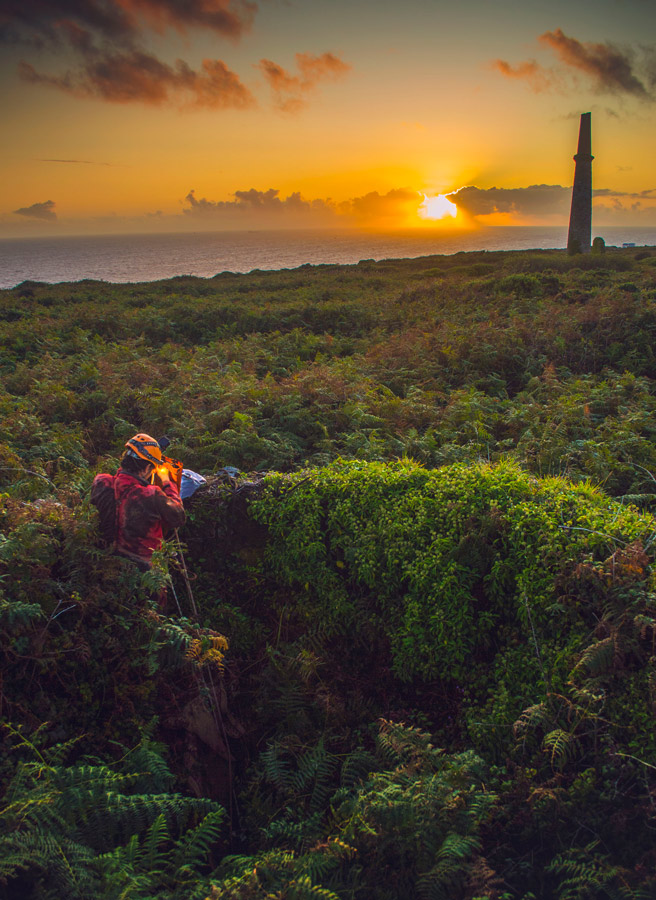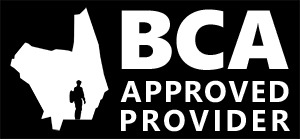Equipment for SRT and Vertical Mine and Cave Exploration
Exploring caves and abandoned mines via single rope technique (SRT) is, for many, one of the main attractions of subterranean exploration. Needless to say, vertical exploration can only be done with specialist equipment. In this article, we’ll take a close look at the essential equipment you need for SRT exploration.
This article contains affilaite links. If you make a purchase via any of the links in this page, we may earn a small commission at no extra cost to yourself. Thank you.
In part 1 of this series, we looked at the essential equipment to get started as an underground explorer. As your experience grows, it is likely that you will want to start exploring more challenging underground objectives, and this will almost certainly incorporate elements of vertical exploration.
Indeed, for many, it is one of the main reasons we became interested in the sport in the first place. Please note that this article is not a ‘how-to’ on SRT techniques. Do not attempt any exploration without the appropriate knowledge and equipment, or without the instruction of someone that you know is competent enough to lead you.
Part 1 of this article recommended a progressive approach to building up your caving equipment. It’s quite possible to build your initial equipment setup with just a few essential items, and then gradually build upon this as you become more immersed in the sport.
Getting yourself equipped for SRT isn’t quite the same. A functioning SRT rig necessarily consists of a number of different components. If any one of these is missing, your ability to move up and down rope will be compromised.
Before we get to the nitty gritty, it can’t be stressed enough that SRT is a complex set of skills that must be learned and practised in a controlled environment (e.g., with a qualified caving instructor). Before you rush out and buy your gear, make sure you have a plan to acquire the skills required to use it safely.
This, of course, means getting training through your local caving club, with experienced peers, and with professional instruction. The value of the latter should not be overlooked. Your caving/mine exploring friend may have a lifetime of safe underground experience behind them. But it is also possible that they may not be up to date with the current best practice, and they may have one or two bad habits they may unwittingly pass on to you.
Excellent resources exist online and in print to assist you with learning the details of SRT. I strongly recommend you devour as much of this material as you can. However, this should be used along with learning first-hand from experienced underground explorers. I cannot recommend a 100% teach-yourself-SRT approach.
What Makes Up an SRT Setup?
A single rope technique setup has to safely fulfil several roles. At its most fundamental, it must allow you to be attached to a rope, or ropes, and prevent any unplanned parting between you and said ropes.
In order to do this, we need a harness suitable for SRT, and central attachment strong-point, usually a ‘D-ring’ carabiner. Finally, we need some kind of device that is the go-between from our D-ring to the rope itself. The choice of device varies depending on the way in which we want to move. Traversing, descending, and ascending, are all very different types of movement, and a different device is required for each of these manoeuvres.
As any underground excursion will likely require all of these types of movement, we therefore need the full gambit of equipment with us at all times. Not only for our planned route, but also in case plan A goes awry.
For example, on a simple trip involving one abseil to an easy walk-out, we could argue that ascending devices aren’t needed, as we simply plan to descend the rope and then walk out of the system. However, what if for any reason, you can’t make it to the bottom of the pitch? You’re suddenly in a very serious predicament if you can’t do a change-over and re-ascend to safety.
You could easily imagine an infinite number of scenarios, such as the example above, where being under-equipped when vertically exploring, could make an innocuous situation potentially fatal. What’s more, a full SRT rig doesn’t weigh much, so there’s no excuse for not carrying your full setup whenever any elements of verticality are anticipated.
A fully functioning harness will also need various accessory pieces of equipment, depending on what kind of ascending and descending devices you have chosen to work with.
Let’s take a more detailed look at the individual components of an SRT rig.
- SRT Harness
- D-Ring Carabiner
- Chest Harness
- Cowstails
- Descending Device
- Ascending Devices
- Foot loop
- Additional Equipment for Rigging and Rescue
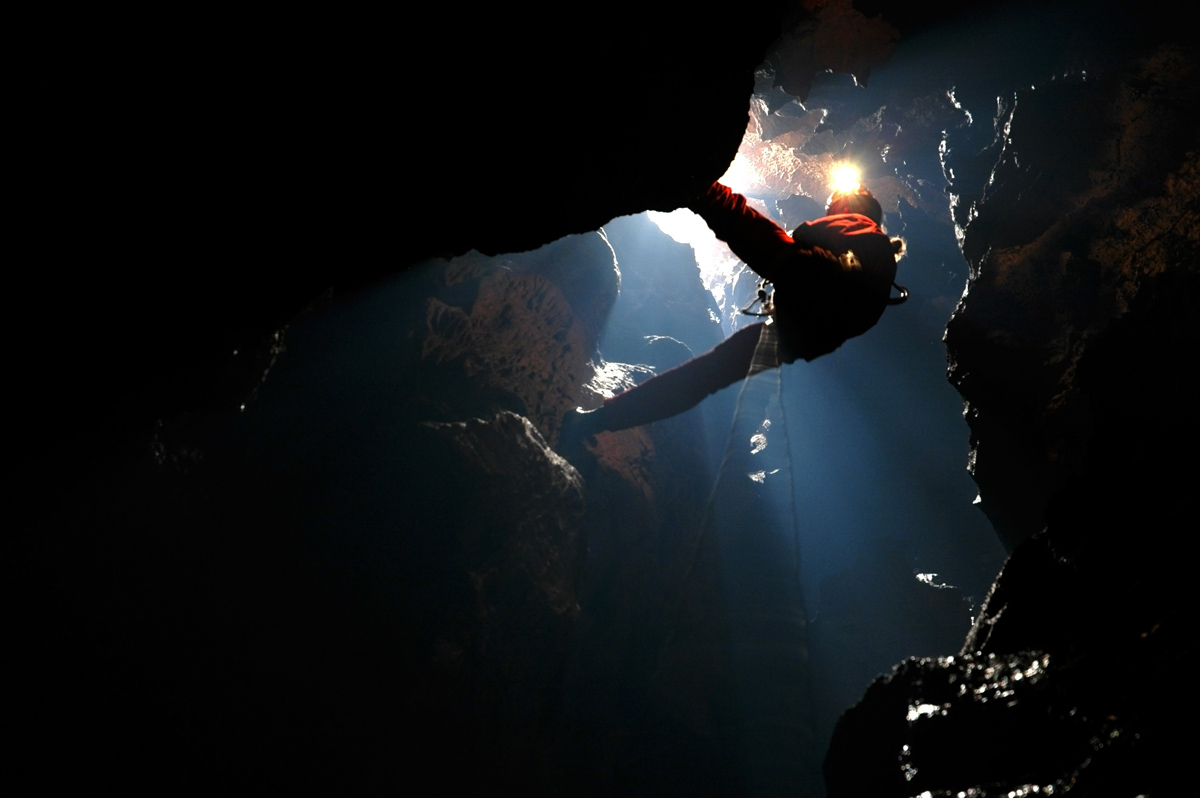
SRT Harness
As humans have learned various ways to enjoy exploring and even working in the vertical environment, a wide array of equipment has become available to fulfil these specific niches.
For example, rock climbing, arborism, and caving all have the use of ropes in common. But they also differ hugely in the details. As a result, practitioners of each of these types of activities must seek out the right tools for the job.
Do your research and make sure you’re getting the appropriate equipment. Whilst a rock-climbing harness will keep you safe underground, it is not optimised for SRT at all. An SRT harness will generally have a much greater amount of padding, as we very much expect to be sitting in the full weight of our harness for potentially prolonged periods.
SRT harnesses are all built around the concept of a central connection point (a D-ring). This is particularly important when ascending. As we alternately shift our weight between our body and our foot ascender, the distances between our ascenders must be carefully controlled to allow maximum efficiency of our setup.
If, for example, you were to try and do this using a rock-climbing harness, your two ascenders would sit so close together that only a pitiful amount of upward progress could be made with each movement. Ask any climber who has prusiked up a rope using two pieces of accessory cord – it does work, but it is far from easy.
Various manufacturers of climbing and caving equipment exist that provide solutions to our needs as underground explorers. But one brand you cannot ignore is Petzl. Even though they are now world leaders in all forms of equipment for verticality, from industrial access, to arborism, and climbing, they were originally founded by caver, Ferdinand Petzl. At a time when no caving equipment was available, Mr. Petzl designed and made his own.
Petzl are the undoubted world-leader in caving hardware, so most of the recommendations in this article will be for items made by Petzl. Many of these items are ubiquitous, and in some cases, it would take a deliberate effort to find a solution that was not made first by Petzl.
For my SRT harness, I use the Petzl Superavanti. It’s a simple SRT harness and its advantages are that it is low profile and lightweight. It has two simple gear loops and only a modest amount of padding. It’s ideal for underground exploration that doesn’t include repeated long pitches, and is ideal for squeezing and scraping through the rest of the cave/mine system without unnecessary encumbrance.
However, if you think you’ll be spending long periods of time descending long pitches, or even hanging, for example equipping a route, you may wish to opt for something a bit more robust. CUA’s Ben uses the MDTE Picos. It has significantly more padding than the Superavanti, ideal for hanging for long periods and drilling bolts into Cornish granite.
D-Ring Carabiner
An SRT harness requires a D-ring carabiner to bring it all together. The D-ring is your attachment point, and sits front and centre of your harness. It is important that it is a D-shaped carabiner, as such a carabiner is able to take loads in all directions.
A traditional pear-shaped carabiner, for example, is only supposed to be loaded along it’s long axis, and is therefore wholly unsuited as your central attachment point. A D-shaped carabiner can simultaneously take loads 180 degrees along its long axis (where your harness will be attached), as well as in any other direction, i.e., at 90° to this as you descend a rope.
The traditional choice for a D-ring carabiner is something like a Maillon Rapide Half Moon Quick Link. Carabiners of this style require the use of a spanner to tighten / loosen them before and after use (making them finger tight only is not considered safe practice).
Most cavers and mine explorers opt for this kind of D-ring. I personally much prefer using the Petzl Omni. The Omni is a D-ring carabiner with a twist-lock mechanism that keeps the gate closed. I have heard stories of these opening unexpectedly during use, so I always keep an eye on mine. I’ve never had any problems, so am happy to recommend them.
Chest Harness for SRT
Most SRT harnesses don’t come with a built-in chest harness. A chest harness ensures that the harness stays in position, particularly when not loaded. It also crucially helps keep your ascender in the correct position to achieve efficient upward progress.
Chest harnesses are not required to be load bearing and you can in fact use any piece of string or cord to do the job. However, I don’t recommend that. The simplest chest harnesses are inexpensive and will improve the function and comfort of your setup.
I use the Petzl Torse. Heavier chest harnesses, with more features, such as extra gear loops, are available too
Cowstails
The next piece of your SRT rig will be a set of cowstails. Cowstails allow the user to safely traverse across pre-rigged traverse lines. They also act as vital intermediate attachment points as you change modalities, for example, attaching yourself to a pitch head as you complete a traverse and prepare for descent.
A set of cowstails is a length of dynamic rope which is attached near its centre by an overhand knot which loops onto your D-ring.
The resulting two lanyards (or cowstails) will have a carabiner attached to the other end, usually via a fisherman’s, or stopper, knot.
At least one locking carabiner is recommended in your cowstail configuration. But as you never know which lanyard you’re going to need the locker on, I recommend having a locker on both. To save faff with a screwgate carabiner, having some kind of twist-locking carabiner on your cowstails ensures maximum safety and efficiency. I recommend the Petzl Wirelock.
If you’ve never tied your own cowstails before, get an experienced caver or instructor to help you. You can find detailed instructions in both The Complete Caving Manual, and Alpine Caving Techniques. These are two indispensable volumes that every caver and mine explorer should have on their bookshelf. Make sure to have your work checked before use.
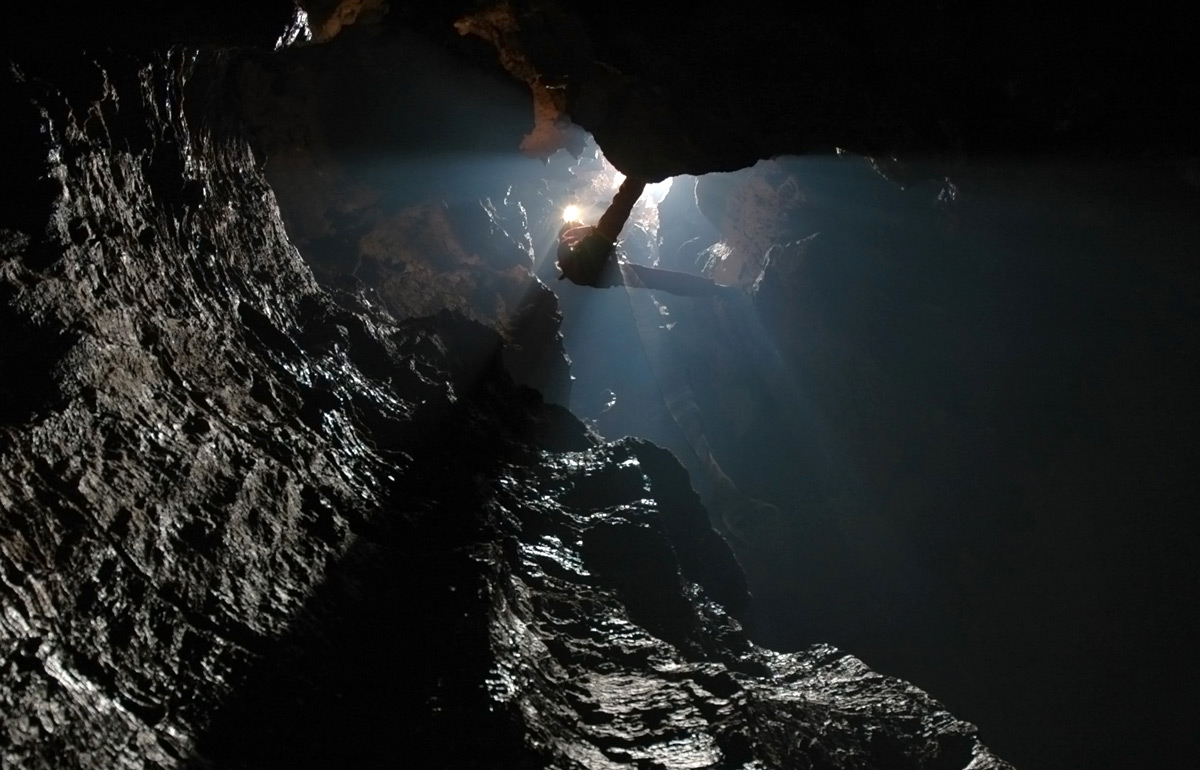
Descending Device for SRT
Descending is where the fun starts. Descent can get an explore straight off to an exciting start. Or if you know the first pitch is coming, there’s undeniably going to be plenty of anticipation as we make our way to the pitch head.
Whilst various devices suitable for descent in caves and mines do exist, I’m going to recommend one only: the Petzl Stop. The Petzl device is ubiquitous amongst underground explorers and it’s not common to see other devices in use.
There are exceptions. Older cavers may still be using their trusty ‘rack’, as well as those who are frequently taking on huge pitches, where the better heat dissipation of the rack starts to outweigh its disadvantages.
There are also devices with additional braking functionality, such as the Petzl Rig. Devices such as this are perhaps using a sledgehammer to crack a nut. They are very suitable to anyone leading people underground, and indeed, we use the Petzl Rig when leading all of our trips at Cornwall Underground Adventures.
The Petzl Stop
There is only one realistic choice of descending device for the modern caver. The Petzl Stop. It has passed the test of time, and a relatively recent additional of a braking handle removed any niggling doubts the caving community may have had about its safe performance.
It performs perfectly in the rigours of underground exploration, so you can tackle any pitch knowing you have the right tool for the job. Also, almost every other caver or mine explorer you meet will be using a Petzl Stop. Therefore, if you have any questions or problems, someone on your expedition will likely know the answer.
Also, if you happen to be doing anything wrong (for example rigging it backwards), as it is familiar to all, there’s a much better chance of one of your peers noticing and pointing it out. If you’re using an obscure device that no one else is familiar with, you don’t have that back-up.
Braking Carabiner
Safe use of a Petzl stops involves incorporating a braking carabiner in the system, This needn’t be anything flash, indeed a large HMS carabiner will definitely hinder your abseiling progress. If you want to go for a bombproof option that will last you years, get a steel carabiner. However, any standard snap-gate (EN 12275) carabiner will do, such as this DMM Phantom wire gate.
Ascending the Rope
With cowstails and a suitable descending device, we’re set for traversing and going down rope. Finally, we need the items necessary for ascending the rope.
For this task, we generally use toothed rope jamming devices. All such devices work on the basic principle of allowing the rope to pass in one direction only, with the toothed component preventing the rope passing back through the device.
We variously call such devices, ascenders, jammers, or jumars (to use a brand name generically). A standard SRT setup will have a body jammer and a hand jammer.
Body Jammer – Petzl Croll
Possibly more ubiquitous than the Petzl Stop, the body jammer of choice is the simple toothed-device, the Petzl Croll. The croll attaches to the D-ring and is held up by the chest harness threading directly through the hole in the top of the croll.
Lightweight, and extremely simple in design, I don’t think I’ve ever encountered a caver or mine explorer using any other type of device as their body jammer.
Hand Jammer
Another toothed device typically serves as our other ascending device. There are two main types – a basic toothed device, or one with a in-built handle.
There are advocates of either type of device. Some schools of thought suggest that the use of a handled device can lead to an over-reliance on arm power when ascending, reducing the efficiency of the operation, and leading to less-than-perfect technique.
With a device lacking a handle, it’s less easy to pull on it, and therefore can only be used by the hands to keep you in balance and requiring the upward thrust to come just from the legs, our biggest muscles.
Below is a selection of non-handled and handled devices.
Foot Loop for Ascending
A short length of relatively thin (e.g. 8mm) static rope is required to make your foot loop. Efficient SRT depends on precise setting up of your system. A key part of this is getting the lengths of your foot loop the right length. There is no generic way to do this, as it completely depends on the size of your body.
There are comprehensive explanations of how to do this in the Compete Caving Manual and Alpine Caving Techniques. These are both essential reference volumes for any serious caver or mine explorer, so grab your copies if you don’t already own them.
Yes, I know I’m being repetitive, but I can’t stress enough the importance of being fully practised and experienced in using your SRT rig before going on the sharp end. Practise, practise, practise!
Two locking carabiners are needed for your footloop setup. The first will link to your D-ring, the second will attach to your ascending device via knot on a bight. This allows a length of rope to go back to your D-ring. The other end of the rope forms your foot loop.
Standard aluminium carabiners are perfectly adequate, but you may also consider steel carabiners. The carabiners in your SRT rig take a huge amount of abuse, and for just a tiny amount of extra weight, the longevity and reassurance of steel carabiners may be worth it.
Petzl Shunt
If you are using the SRT setup as prescribed above, i.e., Petzl Stop, Petzl Croll, and an ascender, you should also get a Petzl Shunt. Neither the Stop, nor an ascender are considered the best choices for rigging traverses.
This does give the Petzl Rig one advantage over the Stop, as it is considered by the manufacturer safe to use for rigging traverses.
The solution is a Petzl Shunt. The shunt also has innumerable other uses, but chiefly, can be used to back you up during descent, particularly if you are using double rope technique (DRT). They are also very handy devices for hoisting and other recuse techniques.
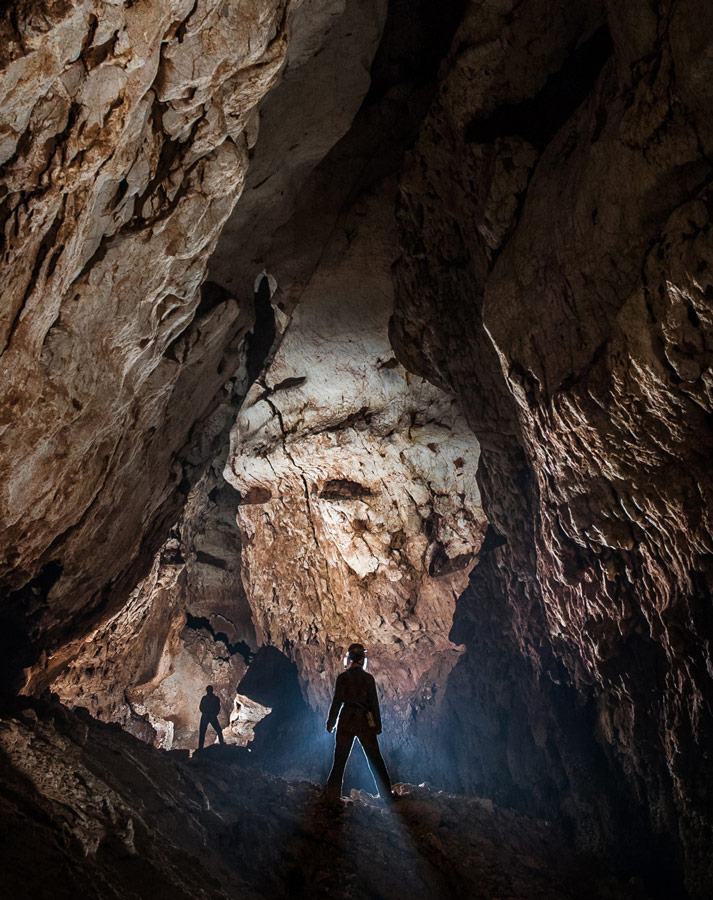
Additional Equipment for SRT
With all of the gear listed above, your persoanl SRT system is complete. You are now fully equipped to go vertical caving and mine exploring with other experienced undergound explorers. Read on to see what extra kit you may need.
Carabiners for Caving
Your SRT rig necessarily has six carabiners necessary for it to function (seven, if you include the D-ring). You will have two locking carabiners for your cowstails, 2 locking carabiners in your foot loop setup, and a locking and a braking carabiner for your Petzl Stop.
If you are rigging traverses and pitches, you’re also going to need additional carabiners to attach ropes to your anchor points. On top of this, you may need a carabiner or two to set up deviations in the rope.
In general, oval carabiners are the weapon of choice for all of the uses mentioned above. They are best suited for ease of use and remaining strong in a variety of pull directions. They are still much weaker when cross-loaded, so bear that in mind.
The number of carabiners needed for any trip will, of course, vary hugely. You may just need a couple if your objective only has one pitch. Note also that if the in-situ anchors are resin bolts, it may be possible to tie the rope directly into these. To build up your rack, acquire a few carabiners to begin with and add to this as and when you can.
Where possible, prior knowledge of your route, be it word of mouth from people who have done it, or a reliable rigging plan, will help you prepare accordingly. However, if you are exploring new ground, you may have to take every bit of metalwork you and your friends can muster.
Bear in mind, in such a scenario, use of a drill and a knowledge of how to place safe bolts will be required. That’s a HUGE topic in itself and beyond the scope of this article.
Slings
Slings have many uses, but the most frequent uses are:
- Using one as a bandolier to carry your carabiners and other bits and pieces of SRT gear
- Lark’s footing one to your D-ring to make an additional lanyard for carrying rope bags or any other equipment you may need to take with you are you negotiate the vertical environment.
- Using them for deviations for good rope management on pitches.
Therefore, 2 to 3 slings should be included in your SRT gear. Slings can come in very thin diameters, but the abrasive underground environment will not be kind to them. So rather than trying to make minimal savings in weight, go for something chunky that will have a good lifespan. 16mm x 120cm slings will be perfect.
Rescue Devices
You may want to add a couple of gadgets to your rack that allow you to perform basic rescues. Indeed, at least one member of any trip requiring SRT should have these with them.
The Micro Traxion is a progress capture device. Similarly to your ascender, or your croll, it is a toothed device that only allows the rope to move through it in one direction. In many use cases, you could use a shunt instead, but a shunt will be less efficient.
Like many rope devices, progress capture devices have endless uses, only limited by the user’s creativity. But they are invaluable in basic rescues, such a 2:1 hoists and simple traverse rescues.
If you, for example, have to set up a 2:1 hoisting system and you don’t have a pulley, don’t worry, it can work. But boy, it will be so much easier if you can incorporate a pulley (or two) into the set up. The exponential reduction in friction will make the manoeuvre so much easier.
Pulleys come in all shapes and sizes, with different uses in mind. Make sure you get a pulley that is made by a reputabe caving/climnbing/arborism manufacturer and is rated and certified for your intended use. You can't go wrong with the Petzl Partner.

Ropes for SRT
All SRT should be performed on semi-static, i.e., low stretch ropes. Furthermore, make sure you are using ropes that have EN 1981 certification, and ideally are type ‘A’.
For some more information about rope types, have a read ofa this article.
The rope length you need will vary depending on your objectives. The standard lengths of rope are 25m, 50m, and 100m, although rope can be ordered, or cut, to almost any size. Again, some prior knowledge of your objective should inform you how much rope to take. And, of course, ALWAYS tie a knot in the end of your rope before use.
If you’ve read part 1 or part 2 of these articles and think there are items missing, you’ll probably find them in part 3 – accessories for caving and mine exploration (coming soon).
